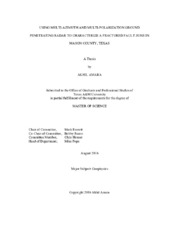| dc.description.abstract | A multi-azimuth and multi-polarization ground penetrating radar (GPR) survey is
carried out to help characterize a fractured fault zone located in Mason County, Texas. A total of 36 lines were acquired on and near the fault zone to try to identify the GPR
signature of a complex fracture system. These lines were run through a standard set of
processing steps to try to identify the fractures. The results showed that the multi-azimuth survey helped identify the dominant strike of the fractures, which was parallel to the strike of the fault (NE-SW). The multi-polarization survey helped identify the different fills of the fractures. Due to the orientation of the fractures, the PP orientation showed the resistive fractures while the TT orientation showed the conductive fractures.
gprMax, a 2-D finite-difference time-domain GPR simulation software, was used
to confirm the results seen in the field data. Two 2-D models were created to understand the GPR response of the different fracture fills in the TT orientation. The first model simulated 3 identical fractures with 3 different fracture fills (air, water, clay). Results of this model showed that in the TT orientation, the air filled fractures have the weakest response while the clay filled fractures have the strongest response. The second model simulated the dominant fractures seen in Line A, PP and TT orientations. The results again showed that in the TT orientation, conductive fractures have the strongest response while the resistive fractures have the weakest response, confirming the results from the field data.
A geophysical workflow was proposed to help identify buried shallow faults in
remote locations. This workflow will help enhance the field observations of an area. The
workflow goes from surveying a large area (100s of m) using aeromagnetic data to
identifying fractures in a fault zone at cm scale by using GPR method shown in this
research. | en |


